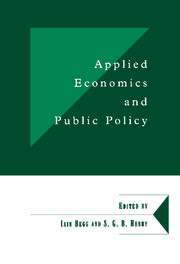Book contents
- Frontmatter
- Contents
- List of figures
- List of tables
- List of contributors
- Foreword
- 1 Introduction
- Part One MODELLING AND FORECASTING METHODS
- Part Two COMBINING DATA AND ANALYTIC TECHNIQUES
- Part Three USING MODELS TO GUIDE POLICY
- 10 On the equilibrium properties of macroeconomic models
- 11 Empirical analysis as an underpinning to policy
- 12 Using figures to guide macroeconomic policy
- Bibliography
- Index
10 - On the equilibrium properties of macroeconomic models
from Part Three - USING MODELS TO GUIDE POLICY
Published online by Cambridge University Press: 06 July 2010
- Frontmatter
- Contents
- List of figures
- List of tables
- List of contributors
- Foreword
- 1 Introduction
- Part One MODELLING AND FORECASTING METHODS
- Part Two COMBINING DATA AND ANALYTIC TECHNIQUES
- Part Three USING MODELS TO GUIDE POLICY
- 10 On the equilibrium properties of macroeconomic models
- 11 Empirical analysis as an underpinning to policy
- 12 Using figures to guide macroeconomic policy
- Bibliography
- Index
Summary
Introduction
Macroeconomic models were first estimated as an aid to understanding the behaviour of the economy in the short to medium term, that is, over a horizon of about six months to about two or three years. But there has been some shift of attention in the past ten years or so away from relatively short-term demand stabilisation policy questions to supply-side issues which require a more extended view. The Government has a medium-term financial strategy. The behaviour of financial markets has drawn attention to the way in which expectations about the distant future can have immediate effects. The result for macroeconomic modellers has been rather more attention paid to the long-term properties of models. These issues were addressed specifically in Hargreaves (ed.) (1992).
In Britain there is a long tradition of using estimated macroeconomic models in the design of macroeconomic policy. The research has been undertaken, continuously since the 1950s, at the National Institute of Economic and Social Research, the London Business School and the Department of Applied Economics at Cambridge, to mention just three of the many institutions involved. The practical use of models has been the responsibility of the Treasury and the Bank of England, where some innovative model-building has also taken place. In this paper we concentrate mainly on the use of models to describe the consequences of monetary policy changes.
- Type
- Chapter
- Information
- Applied Economics and Public Policy , pp. 225 - 246Publisher: Cambridge University PressPrint publication year: 1998

